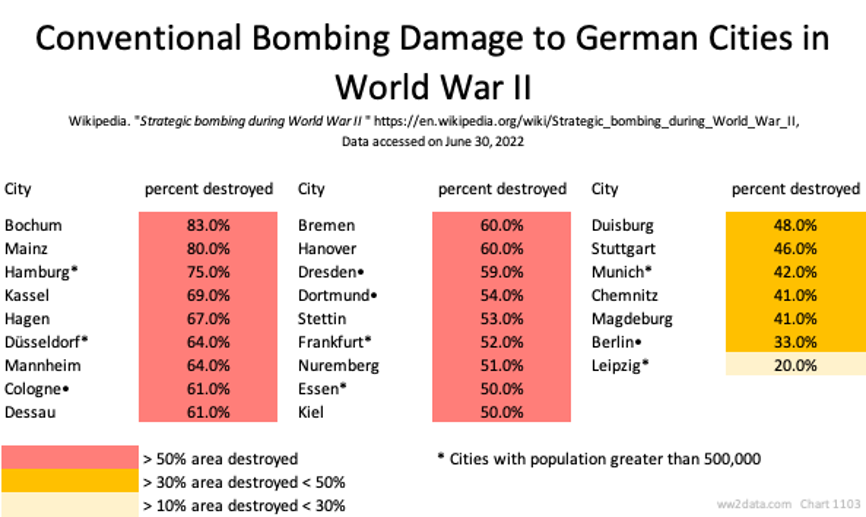The effects of conventional bombing by the Allies during World War II on German cities were devastating. The scale of the destruction was immense, and the human cost was catastrophic. Seven German cities with populations greater than 500,000 suffered more than 50 percent destruction. These estimates by the RAF showed the extent of Allies strategic bombing on Germany.

Table of Contents
Strategic Bombing
Allied strategic bombing aimed to eliminate military and infrastructure targets as well as deliver a blow to German morale. Germany pivoted its air and antiaircraft weapons to counter the United Kingdom (UK) and United States (US) air forces attacks. These German resource allocations against Allied strategic bombing limited what could be utilized on the Eastern Front. Although strategic bombing wasn’t the invasion desired by Stalin it began chipping away and then devasting Germany’s fighting capability.
Cities
The Allies first embarked on bombing campaigns against German cities in 1940, with the first UK large-scale night raid occurring over the city of Hamburg in July of that year. This was followed by a sustained campaign of night raids over major cities such as Berlin, Cologne, Dortmund and Dresden. The bombing raids inflicted massive damage to buildings, infrastructure and civilian lives. Entire city districts were obliterated, leaving behind a devastated landscape of rubble, dust and smoke.
These raids also caused huge disruption to transportation, as well as electricity and water supplies. In addition to the physical damage caused by the raids, the psychological effects on civilians were also profound. Many were traumatized by the experience, with the experience of the raids leaving deep emotional scars.
The situation worsened further in January 1943 when the US Army Air Forces (USAAF) conducted their first daylight bombing raid on the submarine bases at Wilhelmshaven, Germany. Prior to time the USAAF had only directed at German targets in France. With the Wilhelmshaven raid began a sharing of duties whereby the UK would bomb Germany at night and the US during the day. This duty sharing arrangement gave the German defenders little time for rest.
Hamburg
The single most intense targeting of a single city began on July 24, 1943, against Hamburg lasting eight days and seven nights. By July 27 a combination of factors resulted in the eruption of a firestorm. The weather was unusually dry and warm and firefighting was limited by previous bomb damage as well as withdrawal of other cities firefighters. Prior to these raids the British Royal Air Force determined how to most effectively use incendiary bombs. High explosive bombs were used first to blow out windows and followed up with the incendiary bombs. Finally delayed fused high explosives were also included to deter firefighting efforts. Approximately half of the 37,000 Hamburg’s deaths occurred that night.
In total, over 600,000 German civilians were killed during the war in conventional bombing raids. In addition to this, millions more were displaced and left homeless by the raids.
Conventional Bombing Damage to German Cities in WW2 Data
The above graph can be downloaded as an image.
To download the data shown below from which the graph was developed click on the icon below corresponding to you desired format. Note: to ensure all data is downloaded choose the ‘All’ selection in the Show Entries dropdown list. Otherwise only the data visible on the screen will download.
*Cities with population greater than 500,000
Source: Wikipedia. “Strategic bombing during World War II” https://en.wikipedia.org/wiki/Strategic_bombing_during_World_War_II, Data accessed on June 30, 2022
Other Data Links
Conventional Bombing Damage to Japanese Cities in WW2
Allied Estimated Usage of the 30,000 plus V-1s Built
USAAF 8th and 15th Tonnage Dropped on German Aircraft Industry
This website, ww2data.com, has no responsibility for the persistence or accuracy of URLs for external or third party internet websites referenced. Nor does ww2data.com guarantee that any content on such websites are accurate or will remain accurate.

Leave a Reply